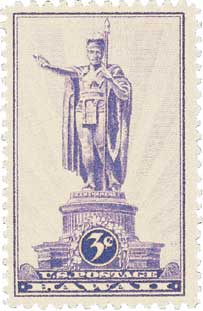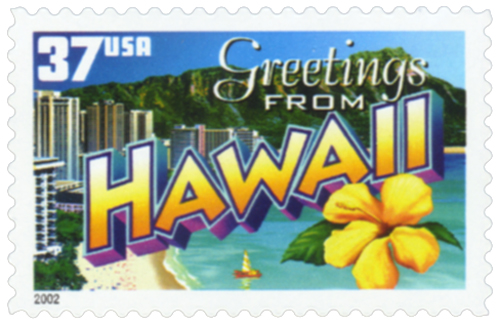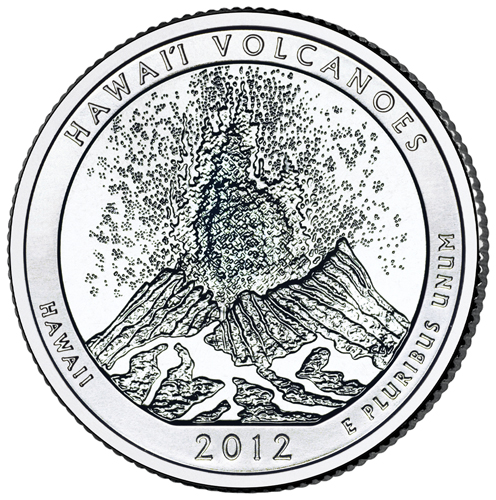
# 3706 FDC - 2002 37c Greetings from America: Hawaii
37¢ Greetings From America
Hawaii
City: New York, NY
Quantity: 200,000,000
Printed By: American Packaging Corp. for Sennett Security Products
Printing Method: Photogravure
Perforations: Serpentine Die Cut 10.75
Color: Multicolored
On August 1, 1916, President Woodrow Wilson established Hawaii National Park – America’s 11th national park and the first established in a US territory. The name was later changed to Hawai’i Volcanoes National Park. The Hawaiian islands are constantly changing due to their location near the middle of the Pacific Plate, the world’s largest tectonic plate. Over millions of years, this plate moved over a “hot spot” or plume that creates volcanic activity. As the plate moved and volcanic eruptions occurred, each of the Hawaiian islands formed – a total of eight major islands and 124 islets spanning across 6,424 square miles. The Big Island of Hawaii was the most recent to form. Its evolution began more than one million years ago as five separate volcanoes at the bottom of the ocean. Over the years, each of volcanoes erupted repeatedly, each time adding thin sheets of lava over top of the old layers. Eventually, the mountains began to emerge from under the water. The lava from each volcano’s eruption overlapped over time, joining the five mountains into one large island. The first mountains to form were the Kohala, as they were the first to be located above the hot spot. As the plate shifted, each volcano had its turn over the hot spot, with Mauna Kea coming next, then Hualalai, Mauna Loa, and lastly, Kilauea. As Kilauea continues to erupt today, it spews out molten lava that flows to the ocean, creates rock, and increases the size of the island. The first inhabitants of Hawaii were Polynesians from the Marquesas Islands who arrived more than 1,600 years ago. These first people had a well-established society when Polynesians from the Society Islands arrived about 800 years later. The new Polynesians claimed they were descended from great gods and took over the islands. For centuries, the two groups developed a unique Hawaiian culture based on a system of laws known as kanawai. Captain James Cook’s arrival on the islands in 1778 marked the beginning of the end for the traditional Hawaiian culture. As word spread of the exotic island, more and more explorers and missionaries were drawn to Hawaii. Among the first recorded European visitors to the area of the present-day park were English missionary William Ellis and American missionary Asa Thurston. By the 1840s, the Kilauea volcano was a popular tourist attraction, and businessmen opened several hotels at the rim of the volcano. In 1891, Lorrin A. Thurston, son of Asa Thurston, became an investor in one of the rim hotels. However, he soon discovered the damage caused by all the visitors. In 1903, William R. Castle first proposed that the area be made a national park. Soon, Thurston began lobbying for the park and printing editorials in favor of this in his newspaper. Due in part to these efforts, the Hawaii territory sponsored a trip inviting 50 members of Congress and their wives to visit the island and see the sights for themselves. Within a couple of years, Hawaii’s governor created a draft bill, proposing the creation of the Kilauea National Park. Thurston worked with local landowner William Herbert Shipman to map out proposed boundaries. He also continued to print endorsements from such famous names as John Muir, Henry Cabot Lodge, and Theodore Roosevelt. Hawaii delegate Kuhio Kalaniana’ole introduced legislation for the park several times before it was finally approved and signed into law by President Woodrow Wilson on August 1, 1916. Hawaii National Park was the 11th US National Park and first to be established in a territory. Because of the island’s numerous active volcanoes, the landscape of the park has continued to change over the years. One of the largest changes came in the fall of 1959 due to several earthquakes. On November 14, there were 10 times as many earthquakes as there had been the previous day. That night, a more than month-long eruption began, creating lava fountains of more than 300 feet high, a new cinder cone, a lava lake, and several forest fires. By December 20, after 16 explosive episodes, the eruptions were done, and the landscape was dramatically changed. What was once a dense rain forest was transformed into a field of hardened lava. The Devastation Trail was later established there to give visitors an up-close view of the results of such an eruption.Hawaii Volcanoes National Park







37¢ Greetings From America
Hawaii
City: New York, NY
Quantity: 200,000,000
Printed By: American Packaging Corp. for Sennett Security Products
Printing Method: Photogravure
Perforations: Serpentine Die Cut 10.75
Color: Multicolored
On August 1, 1916, President Woodrow Wilson established Hawaii National Park – America’s 11th national park and the first established in a US territory. The name was later changed to Hawai’i Volcanoes National Park. The Hawaiian islands are constantly changing due to their location near the middle of the Pacific Plate, the world’s largest tectonic plate. Over millions of years, this plate moved over a “hot spot” or plume that creates volcanic activity. As the plate moved and volcanic eruptions occurred, each of the Hawaiian islands formed – a total of eight major islands and 124 islets spanning across 6,424 square miles. The Big Island of Hawaii was the most recent to form. Its evolution began more than one million years ago as five separate volcanoes at the bottom of the ocean. Over the years, each of volcanoes erupted repeatedly, each time adding thin sheets of lava over top of the old layers. Eventually, the mountains began to emerge from under the water. The lava from each volcano’s eruption overlapped over time, joining the five mountains into one large island. The first mountains to form were the Kohala, as they were the first to be located above the hot spot. As the plate shifted, each volcano had its turn over the hot spot, with Mauna Kea coming next, then Hualalai, Mauna Loa, and lastly, Kilauea. As Kilauea continues to erupt today, it spews out molten lava that flows to the ocean, creates rock, and increases the size of the island. The first inhabitants of Hawaii were Polynesians from the Marquesas Islands who arrived more than 1,600 years ago. These first people had a well-established society when Polynesians from the Society Islands arrived about 800 years later. The new Polynesians claimed they were descended from great gods and took over the islands. For centuries, the two groups developed a unique Hawaiian culture based on a system of laws known as kanawai. Captain James Cook’s arrival on the islands in 1778 marked the beginning of the end for the traditional Hawaiian culture. As word spread of the exotic island, more and more explorers and missionaries were drawn to Hawaii. Among the first recorded European visitors to the area of the present-day park were English missionary William Ellis and American missionary Asa Thurston. By the 1840s, the Kilauea volcano was a popular tourist attraction, and businessmen opened several hotels at the rim of the volcano. In 1891, Lorrin A. Thurston, son of Asa Thurston, became an investor in one of the rim hotels. However, he soon discovered the damage caused by all the visitors. In 1903, William R. Castle first proposed that the area be made a national park. Soon, Thurston began lobbying for the park and printing editorials in favor of this in his newspaper. Due in part to these efforts, the Hawaii territory sponsored a trip inviting 50 members of Congress and their wives to visit the island and see the sights for themselves. Within a couple of years, Hawaii’s governor created a draft bill, proposing the creation of the Kilauea National Park. Thurston worked with local landowner William Herbert Shipman to map out proposed boundaries. He also continued to print endorsements from such famous names as John Muir, Henry Cabot Lodge, and Theodore Roosevelt. Hawaii delegate Kuhio Kalaniana’ole introduced legislation for the park several times before it was finally approved and signed into law by President Woodrow Wilson on August 1, 1916. Hawaii National Park was the 11th US National Park and first to be established in a territory. Because of the island’s numerous active volcanoes, the landscape of the park has continued to change over the years. One of the largest changes came in the fall of 1959 due to several earthquakes. On November 14, there were 10 times as many earthquakes as there had been the previous day. That night, a more than month-long eruption began, creating lava fountains of more than 300 feet high, a new cinder cone, a lava lake, and several forest fires. By December 20, after 16 explosive episodes, the eruptions were done, and the landscape was dramatically changed. What was once a dense rain forest was transformed into a field of hardened lava. The Devastation Trail was later established there to give visitors an up-close view of the results of such an eruption.Hawaii Volcanoes National Park















